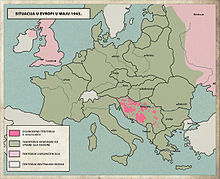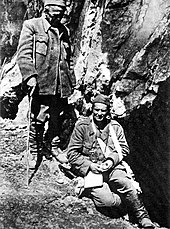Case Black
| Case Black | |||||||
|---|---|---|---|---|---|---|---|
| Part of World War II in Yugoslavia | |||||||
 Map of Case Black, superimposed on modern-day borders | |||||||
| |||||||
| Belligerents | |||||||
|
Axis: |
Allies: | ||||||
| Commanders and leaders | |||||||
|
|
| ||||||
| Strength | |||||||
|
127,000 men 300+ aircraft | 22,148 men | ||||||
| Casualties and losses | |||||||
|
German casualties: 583 killed, 1,760 wounded, 425 missing[4][5] Italian casualties: 290 killed, 541 wounded, 1,502 missing[6] Croatian casualties: 40 killed, 166 wounded, 205 missing[4][5] Total Axis casualties: 913 killed, 2,467 wounded, 2,132 missing[4][6] |
2/3 killed and wounded[7] (6,391[7]–7,543[8][9] killed) | ||||||
| 2,537 pro-Partisan civilian sympathizers executed[10][11] | |||||||

Case Black (German: Fall Schwarz), also known as the Fifth Enemy Offensive (Serbo-Croatian Latin: Peta neprijateljska ofanziva) in Yugoslav historiography and often identified with its final phase, the Battle of the Sutjeska (Serbo-Croatian Latin: Bitka na Sutjesci pronounced [bîtka na sûtjɛst͡si]) was a joint attack by the Axis taking place from 15 May to 16 June 1943, which aimed to destroy the main Yugoslav Partisan force, near the Sutjeska river in south-eastern Bosnia. The failure of the offensive marked a turning point for Yugoslavia during World War II.
The operation immediately followed Case White which had failed in accomplishing the same objectives: to eliminate the central Partisan formations and capture their commander, Marshal Josip Broz Tito.
Operation
The Axis rallied 127,000 land troops for the offensive, including German, Italian, NDH, Bulgarian, and over 300 airplanes. The Yugoslav National Liberation Army had 22,148 soldiers in 16 brigades.[8] After a period of troop concentration, the offensive started on 15 May 1943. The Axis troops used the advantage of better starting positions to encircle and isolate the partisans on the Durmitor mountain area, located between the Tara and Piva rivers in the mountainous areas of northern Montenegro and forced them to engage in a fierce month-long battle on waste territory.
On June 9, Tito was nearly killed, when a bomb fell near the leading group wounding him in the arm. The popular post-war report of the event credited Tito's German shepherd dog Luks, for sacrificing his life to save Tito's.[12] Captain William F. Stuart, a Special Operations Executive operative who was parachuted into Tito's headquarters alongside Captain William Deakin during May,[13] was killed by the explosion, as well.[14]
Facing almost exclusively German troops, the Yugoslav National Liberation Army (YNLA) finally succeeded in breaking out across the Sutjeska river through the lines of the German 118th and 104th Jäger and 369th (Croatian) Infantry divisions in the northwestern direction, towards eastern Bosnia. Three brigades and the central hospital with over 2000 wounded were surrounded. Following Hitler's instructions, German commander in chief Generaloberst Alexander Löhr ordered their annihilation, including the wounded and the unarmed medical personnel. In addition, YNLA troops suffered from severe lack of food and medical supplies, and many were struck down by typhoid.
In total there were 7,543 partisan casualties, more than a third of the initial force.[8] The German field commander, General Rudolf Lüters in his final report described the so-called "communist rebels" as "well organized, skillfully led and with combat morale unbelievably high".
The successful Partisan breakout helped their reputation as a viable fighting force with the local populace. Consequently, they were able to replenish their losses with new recruits, regroup, and mount a series of counterattacks in eastern Bosnia, clearing Axis garrisons of Vlasenica, Srebrenica, Olovo, Kladanj and Zvornik in the following 20 days.
The battle marked a turning point toward Partisan control of Yugoslavia, and became an integral part of the Yugoslav post-war mythology, celebrating the self-sacrifice, extreme suffering and moral firmness of the partisans.
Order of battle

Allied order of battle

![]() Yugoslav Partisans (Partisans Main Operational Group)
Yugoslav Partisans (Partisans Main Operational Group)
- 1st Proletarian Division
- 2nd Proletarian Division
- 3rd Assault Division
- 7th Banija Division
- 6th Proletarian Brigade
- 15th Majevica Brigade
Axis order of battle
- 7th SS Volunteer Mountain Division Prinz Eugen
- 1st Mountain Division
- 118th Jäger Division
- 369th (Croatian) Infantry Division
- Regiment 4 Brandenburg
- reinforced 724th Infantry Regiment (104th Jäger Division)
- 1 Alpine Division Taurinense
- 19 Infantry (Mountain) Division Venezia
- 23 Infantry Division Ferrara
- 32 Infantry Division Marche
- 151 Infantry Division Perugia
- 154 Infantry Division Murge
- forces of Sector Podgorica
- 4th Home Guard Jäger Brigade
- 63rd Infantry Regiment
- 61st Infantry Regiment also in the area
(both units under the command of the 369th (Croatian) Infantry Division)
In Film
Battle of Sutjeska was made into a movie in 1973, Sutjeska, with Richard Burton playing the lead as Josip Broz Tito, leader of the partisan forces.
In song
There are several songs about the Battle of Sutjeska. One of the more popular is called "Sivi Sokole" which translates to peregrine falcon. It mentions the death of Commander Sava Kovačević.
| Serbo-Croatian | English |
|---|---|
|
Sivi sokole, prijatelju stari, Visoka je planina, nebo iznad nje, Duboka je Sutjeska, kanjon iznad nje Na kanjonu Tito stoji i poručuje Sutjeska je probijena, ranjeni su spašeni Radili smo, radimo, radit ćemo još |
Peregrine falcon, old friend of mine, The mountain is high, the sky above it, Sutjeska is deep, the canyon above it Above the canyon stands Tito and commands, Sutjeska is breached, the wounded are saved We have toiled, we toil, we will toil still |
Memorial complex
Sculptor Miodrag Živković designed the memorial complex, dedicating to the Battle of the Sutjeska in the 1970s.[15] The complex contains frescoes by the Croatian artist Krsto Hegedušić.[16]
See also
- Seven anti-Partisan offensives
- Resistance during World War II
- Anti-partisan operations in World War II
Citations
- ^ J. B. Tito, The Yugoslav Road, 99
- ^ Slobodan Nešović, Yugoslav-Bulgarian Relations, 1941-1945, 95
- ^ Jozo Tomašević, The Chetniks, 199
- ^ a b c Report of the commander of German troops in Croatia from the 20th of june 1943 (in Croatian), Collection of Documents and Information on the National Liberation War of the Peoples of Yugoslavia, Volume XII (german documents), book 3, page 94
- ^ a b Report of the commander of German troops in Croatien (Befehlshaber der Deutschen Truppen in Kroatien), June 20th 43, National Archive Washington T314, roll 560, frames 750-751
- ^ a b Cloutier, Patrick (2013). Regio Esercito: The Italian Royal Army in Mussolini's Wars, 1935-1943. lulu.com. p. 182. ISBN 1105074013.
- ^ a b Ante Cuvalo, The A to Z of Bosnia and Herzegovina, 237
- ^ a b c Hoare, Marko Attila (2006). Genocide and Resistance in Hitler's Bosnia: The Partisans and the Chetniks. Oxford University Press. p. 341. ISBN 0-19-726380-1.
- ^ Кучан, Виктор (1996). Борци Сутјеске. Завод за уџбенике и наставна средства: Београд. ISBN 978-86-17-04984-1.
- ^ Andric, Milan (1964). Hronologija oslobodilačke borbe naroda jugoslavije. Beograd: Vojnoistorijski institut. p. 471.
- ^ National Archive Washington T315, roll 1294, frames 537-545
- ^ Doder, Duško (1979). The Yugoslavs. Vintage Books. p. 130. ISBN 978-0-394-74158-1.
- ^ Gilbert, Martin (1971). Winston S. Churchill: Challenge of War 1914-1916. Houghton Mifflin. p. 319. ISBN 978-0-395-13153-4.
- ^ Ritchie, Sebastian (2004). Our Man In Yugoslavia: The Story of A Secret Service Operative. Routledge. p. 46. ISBN 978-0-7146-5559-8.
- ^ Miodrag Živković
- ^ Renata Jambrešić Kirin. The Politics of Memory in Croatian Socialist Culture: Some Remarks
References
Books
- Deakin, Frederick William (1971). The embattled mountain. Oxford: Oxford University Press.
- Maclean, Fitzroy (1949). Eastern Approaches. Penguin Group.
{{cite book}}: Cite has empty unknown parameter:|1=(help) - Schmider, Klaus (2002). Partisanenkrieg in Jugoslawien 1941–1944 (in German). Hamburg: Mittler. ISBN 978-3-8132-0794-1.
{{cite book}}: Invalid|ref=harv(help); Unknown parameter|trans_title=ignored (|trans-title=suggested) (help) - Tomasevich, Jozo (1975). The Chetniks. Stanford University Press. ISBN 0804708576.
- Tomasevich, Jozo (2001). War and Revolution in Yugoslavia: 1941 - 1945. Stanford University Press. ISBN 0804779244.
Journals
- Trifkovic, Gaj. "A Case of Failed Counter-Insurgency: Anti-Partisan Operations in Yugoslavia 1943". The Journal of Slavic Military Studies. 24 (4). Taylor & Francis Group, LLC: 314–336. doi:10.1080/13518046.2011.572733. ISSN 1556-3006. Retrieved 16 June 2014.
External links
- Seven Enemy Offensives
- Yugoslavia in World War II
- Anti-partisan operations of World War II
- Military operations of World War II involving Bulgaria
- Military operations of World War II involving Germany
- Battles and operations of World War II involving Italy
- Battles involving the Independent State of Croatia
- Battles involving the Yugoslav Partisans
- 1943 in Yugoslavia
- Conflicts in 1943
